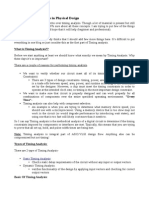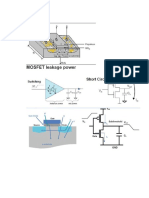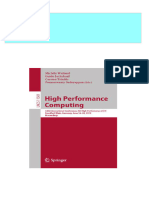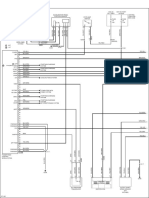Low Power Upf Notes
Low Power Upf Notes
Uploaded by
saugat guhaCopyright:
Available Formats
Low Power Upf Notes
Low Power Upf Notes
Uploaded by
saugat guhaOriginal Description:
Copyright
Available Formats
Share this document
Did you find this document useful?
Is this content inappropriate?
Copyright:
Available Formats
Low Power Upf Notes
Low Power Upf Notes
Uploaded by
saugat guhaCopyright:
Available Formats
Low Power- Upf
UPF
Provides the power-regions, power behavior & associated cells involved.
1. Power & Ground nets.
2. Power switches --> the ones which controls the on/off of a region, there would be multiple power
switches across the entire voltage area just like vias & the count depends on area & IR numbers.
Comes from APR, generally in Floorplan.
The syn stage requires the upf to pass, in case control & ack ports not defined in rtl, create_ports
in syn stage where the rtl is read in.
3. Various Power domains - switching domain, Always ON, different voltages levels, (diff voltages
come in through bumps)
4. Level shifters - connections & locations, needed for the signal/data lines. Comes from synthesis,
only when different voltages exists.
The Isolation Cells hence used the Level Shifters are needed in order to Clamp the output of
powered down voltage going to the
5. State tables- definition of each power domain, which is when ON/OFF
6. ISOLATION cells - Are needed for switching a signal from switching-power domain to a always on-
domain as the always ON domain needs to see some voltage from line to avoid going into
metastable state.
Have seen comes from syn, Where ??, added in APR was the earlier understanding.
This is a Gate type.
Iso cells are always used with level-shifters.
Difference between Retention flops & Isolation cells are that iso cells are of two types always 1 or
always 0 no other type, whereas retention flops should be based on the rtl logic.
Tie cells are different, as gates are not connected directly with the Power - ground supply to
protect the gate from fluctuations, hence through tie-low or tie high cells which ideally should
have diodes or other protections.
1. Retention flops - Are such data holders which hold the data even when the power supply is off,
how is it Done ? The flop sits in power switching domain but has vcc from always ON domain.
Another important point is the retention flop Is for the logic sitting in the switching domain, as this
retains the logic.
This has to come from rtl as which ever signals are important needs to have this, based on the
design.
This is a Register.
7. There are other power buffer cells which are like always on needed for supporting any other
feedthrough signals passing through the power domain.
9. What is power clamp?
Video Tutorials
http://videos.accellera.org/upflowpower/upf38msn6y9/index.html
Design type power consumption, decreasing order
CPU
Modem
GPU
Video
display
Addition to the netlist for upf runs
At Synthesis stage -->
iso cells, retention flops, level shifters
At floorplan stage-->
power switches
Power Domain:
Level shifters Not needed
Power switches --> yes, to control the on/off of the areas.
Retention flops --> Comes from the Rtl
Isolation cells --> Yes needed
CLP - Conformal Low power check
Syn Upf vs Pnr Upf
1. Power switches are added only in the PnR.
Power Domain vs voltage Domain --> Power domain is when the some regions exists which has a
switching supply.
Voltage domain - when there are multiple voltages operating.
FLAT VS HIERARCHICAL CONFIGURATION - uscpc dual supply hierarchical implementation.
########
# Power Domains
create_power_domain PD_TOP -include_scope
create_power_domain PD_ADV -elements { i_rgx_uscpc_av }
########
# Supply Ports & Supply Nets
# vcc always-on supply
####
create_supply_port vcc -domain PD_TOP
create_supply_net vcc -domain PD_TOP
#ADV
create_supply_net vcc -domain PD_ADV -reuse
connect_supply_net vcc -ports {vcc}
####
# svcc_adv switchable supply
create_supply_net svcc_adv -domain PD_ADV -resolve parallel
####
# vss always-on supply
####
create_supply_port vss -domain PD_TOP
create_supply_net vss -domain PD_TOP
#ADV
#create_supply_port vss -domain PD_ADV
create_supply_net vss -domain PD_ADV -reuse
connect_supply_net vss -ports {vss}
########
# Primary Power and Ground Supplies
set_domain_supply_net PD_TOP -primary_power_net vcc -primary_ground_net vss
set_domain_supply_net PD_ADV -primary_power_net svcc_adv -primary_ground_net vss
########
# Power Switches
create_power_switch psw_adv -domain PD_ADV \
-input_supply_port {in vcc} \
-output_supply_port {out svcc_adv} \
-control_port {ctrl0 iso_en_adv} \
-ack_port {ack0 i_rgx_uscpc_av/ack_adv} \
-on_state {on in { !ctrl0 }}
########
# Isolations
set_isolation iso_uscpc_adv -domain PD_ADV -isolation_power_net vcc -applies_to outputs -
clamp_value 0
set_isolation_control iso_uscpc_adv -domain PD_ADV -isolation_signal iso_en_adv -isolation_sense low
-location self
set_isolation iso_uscpc_adv_no -domain PD_ADV -no_isolation -elements {i_rgx_uscpc_av/ack_adv}
########
# Power State Table
# Voltages of port states must match those of operating conditions in libraries.
# Legend: Rv = regular voltage, Lv = low voltage, Wc = worst case opcond, Bc = best case opcond.
add_port_state vcc -state {Rv_Wc 0.900} -state {Rv_Bc 0.900} // This number signifies the Best
corner & the Worst corner voltages.
add_port_state vss -state {Gnd 0.0}
add_port_state psw_adv/out -state {Off off} -state {Rv_Wc 0.900} -state {Rv_Bc 0.900}
create_pst pst_uscpc -supplies {
vcc
vss
psw_adv/out
}
add_pst_state stt_all_on_wc -pst pst_uscpc -state { Rv_Wc Gnd Rv_Wc }
add_pst_state stt_all_off_wc -pst pst_uscpc -state { Rv_Wc Gnd Off }
add_pst_state stt_all_on_bc -pst pst_uscpc -state { Rv_Bc Gnd Rv_Bc }
add_pst_state stt_all_off_bc -pst pst_uscpc -state { Rv_Bc Gnd Off }
## --------------------------------------------------------------------------
## End of file
## --------------------------------------------------------------------------
Files to update the voltages in LP runs:
1. Set voltage --> apr & syn
2. Upf --> apr & syn
3. Mcmm.tcl --> only in apr
Case1: wc=0.9 V, BC= 1.1 V
update the set voltage to 0.9
upf & mccm with both the numbers
Case2: wc=bc=1.4V
Update the set voltage, upf, mcmm =1.4V
Defining proper corners are very important. Else big failure.
You might also like
- ABAP On HanaDocument120 pagesABAP On Hanatemp bilNo ratings yet
- For Iprog ProgramerDocument95 pagesFor Iprog ProgramerEsteban Quito50% (2)
- Medi Sinewave UpsDocument20 pagesMedi Sinewave UpsBabuPD67% (6)
- SynthesisDocument51 pagesSynthesissudhir100% (2)
- Power Gating - Power Management Technique: VLSI Basics and Interview QuestionsDocument12 pagesPower Gating - Power Management Technique: VLSI Basics and Interview QuestionsRohith RajNo ratings yet
- Upf PresentationDocument30 pagesUpf PresentationAnupam Gajendra Narayan ChoudharyNo ratings yet
- SpyGlass CDCDocument11 pagesSpyGlass CDCsamdakNo ratings yet
- RTL Lint Checking LecDocument49 pagesRTL Lint Checking LecNitish Kumar100% (1)
- SpyGlass - CDC - Challenges in Hierarchical Convergence - v1.2 - To - IntelDocument51 pagesSpyGlass - CDC - Challenges in Hierarchical Convergence - v1.2 - To - IntelAnonymous 8FXIq5e1100% (2)
- Key Point MappingDocument69 pagesKey Point MappingVijay SarathiNo ratings yet
- Scenario: + Mode: Supply VoltagesDocument40 pagesScenario: + Mode: Supply VoltagesShwethNo ratings yet
- LEC Verification GuideDocument23 pagesLEC Verification GuideNguyen HungNo ratings yet
- CDC UserDocument479 pagesCDC UserVinoth Kumar67% (3)
- CDC and LINTDocument2 pagesCDC and LINTSrinivas CherukuNo ratings yet
- Sta VlsiDocument40 pagesSta VlsiSanchitJain100% (2)
- VSM SoftwareDocument10 pagesVSM SoftwareMehdi NaderiNo ratings yet
- Logic Synthesis 1 PavanKVDocument80 pagesLogic Synthesis 1 PavanKVdk13071987100% (1)
- Basics of UPFDocument7 pagesBasics of UPFPrabhudatta MohantyNo ratings yet
- Team VLSI SDCDocument11 pagesTeam VLSI SDCNaganithesh GhattamaneniNo ratings yet
- It Is A Process To Convert RTL Code Into Design ImplementationDocument5 pagesIt Is A Process To Convert RTL Code Into Design Implementationsrajece100% (1)
- CDC Tutorial SlidesDocument53 pagesCDC Tutorial SlidesAshok Patil100% (1)
- Timing ClosureDocument23 pagesTiming ClosureSasank VenkataNo ratings yet
- Smart LECDocument42 pagesSmart LECPinky NaharNo ratings yet
- Clock Domain Crossing Issues &Document35 pagesClock Domain Crossing Issues &Nishanth Gowda100% (1)
- 10 Ways To Fix SETUP and HOLD Violation - Static Timing Analysis (STA) Basic (Part-8) - VLSI ConceptsDocument10 pages10 Ways To Fix SETUP and HOLD Violation - Static Timing Analysis (STA) Basic (Part-8) - VLSI ConceptsIlaiyaveni IyanduraiNo ratings yet
- Interview VlsiDocument47 pagesInterview VlsiKulwant Nagi100% (1)
- CDC Signoff Using SDCDocument36 pagesCDC Signoff Using SDCworkat60474No ratings yet
- LowPower Practical Guide April08 ReleaseDocument253 pagesLowPower Practical Guide April08 ReleaseDeepak JagannathNo ratings yet
- Logic Equivalence CheckDocument34 pagesLogic Equivalence CheckROBI PAUL100% (3)
- Negative Skew For Setup: Propagation Delays Load Delays Interconnect DelaysDocument25 pagesNegative Skew For Setup: Propagation Delays Load Delays Interconnect DelaysRajni100% (1)
- UPF Example: UPF For The Above Power Intent: ######## Create Power Domains ###########Document4 pagesUPF Example: UPF For The Above Power Intent: ######## Create Power Domains ###########Mayur Agarwal67% (3)
- SynthesisDocument98 pagesSynthesisROBI PAUL100% (1)
- STA BasicsDocument13 pagesSTA BasicsMaulin Sheth100% (1)
- Getting Started Lab With SpyGlass 450Document47 pagesGetting Started Lab With SpyGlass 450Siva Kamuni50% (2)
- Physical DesignDocument111 pagesPhysical DesignanuhyaNo ratings yet
- SynthesisDocument41 pagesSynthesisFeroz AhmedNo ratings yet
- Low Power DesignDocument43 pagesLow Power DesignAsraa PaulNo ratings yet
- Synthesis Optimization Techniques 7Document11 pagesSynthesis Optimization Techniques 7subha mounika67% (3)
- Setup Hold TimeDocument28 pagesSetup Hold Timeavneesh_singh100% (1)
- Static Timing AnalysisDocument40 pagesStatic Timing Analysissaranya008No ratings yet
- What Is STA ?Document13 pagesWhat Is STA ?veeru100% (1)
- Clock Tree Synthesis - Why Clock Tree Synthesis Is Necessary - CSDN BlogDocument21 pagesClock Tree Synthesis - Why Clock Tree Synthesis Is Necessary - CSDN BlogAgnathavasiNo ratings yet
- Clock Tree Synthesis: Presentation by Sudhir Kumar MadhiDocument69 pagesClock Tree Synthesis: Presentation by Sudhir Kumar Madhisudhir100% (2)
- PD ChecksDocument53 pagesPD ChecksMani Bharath NutiNo ratings yet
- Synopsys Class 2 5 1Document67 pagesSynopsys Class 2 5 1prashanth kumarNo ratings yet
- PD FinalDocument25 pagesPD FinalAnusha ChidagniNo ratings yet
- ASIC PHYSICAL DESIGN - Backend (Physical Design) Interview Questions and AnswersDocument7 pagesASIC PHYSICAL DESIGN - Backend (Physical Design) Interview Questions and Answersdinesh reddy50% (2)
- StaDocument91 pagesStaMohd Mayur100% (1)
- Static Timing Analysis 9100Document32 pagesStatic Timing Analysis 9100Balaji VenkataramanNo ratings yet
- Upf Tutorial InteropforumDocument83 pagesUpf Tutorial InteropforumSayandeep NagNo ratings yet
- Unix Basics and TCL ScriptingDocument49 pagesUnix Basics and TCL ScriptingTaha Perwaiz100% (1)
- CDC Synchronization Best PracticesDocument42 pagesCDC Synchronization Best Practicesvinodkumar kNo ratings yet
- Library Preparation LEF, DEF, GDSDocument51 pagesLibrary Preparation LEF, DEF, GDSROBI PAULNo ratings yet
- LowPower UserDocument74 pagesLowPower Uservinodkumar kNo ratings yet
- Multi Voltage FlowDocument15 pagesMulti Voltage FlowRA NDYNo ratings yet
- MOSFET Leakage PowerDocument47 pagesMOSFET Leakage PowerRamakrishnaRao SoogooriNo ratings yet
- RC Switch by Alan BondDocument4 pagesRC Switch by Alan BondKaisNo ratings yet
- Medi ManualDocument39 pagesMedi ManualBabuPD75% (8)
- Low Power VerificationDocument19 pagesLow Power VerificationJyothi ShrinivasNo ratings yet
- ACCESSIBILITYDocument6 pagesACCESSIBILITYHarsh MandloiNo ratings yet
- Protect HTMDocument5 pagesProtect HTMEugenia del Pilar PalaciosNo ratings yet
- Bateria PTZDocument16 pagesBateria PTZAlexis LópezNo ratings yet
- 8df79 en DiSEqC For TechniciansDocument12 pages8df79 en DiSEqC For Technicianssammydreep100% (1)
- Power Supply Unit (PSU) : Oakley Sound SystemsDocument15 pagesPower Supply Unit (PSU) : Oakley Sound Systemskarimi-15100% (1)
- Complete Download High Performance Computing: 34th International Conference, ISC High Performance 2019, Frankfurt/Main, Germany, June 16-20, 2019, Proceedings Michèle Weiland PDF All ChaptersDocument52 pagesComplete Download High Performance Computing: 34th International Conference, ISC High Performance 2019, Frankfurt/Main, Germany, June 16-20, 2019, Proceedings Michèle Weiland PDF All Chapterslazojacitali100% (2)
- Avr Leroy Sommer R120Document16 pagesAvr Leroy Sommer R120Rony Tri WahyuhadiNo ratings yet
- BT3 IT - Assembling HardwareDocument10 pagesBT3 IT - Assembling HardwareْNo ratings yet
- FC22 - : Name Data Type Address CommentDocument3 pagesFC22 - : Name Data Type Address CommentPradeep TripathiNo ratings yet
- Operating System NACHOSDocument22 pagesOperating System NACHOSChris LazarNo ratings yet
- Unix Administration Interview Questions & Answers On Shell Programming - SanfoundryDocument7 pagesUnix Administration Interview Questions & Answers On Shell Programming - SanfoundrySamikshaNo ratings yet
- MPMC 1st ProgramDocument10 pagesMPMC 1st Programbala krishna NNo ratings yet
- Openutau Crash Log Example 6Document631 pagesOpenutau Crash Log Example 6SergiNo ratings yet
- Design of A Fault Data Collector For Power Distribution Networks For Detection, Location and Classification of Faults Using Machine LearningDocument8 pagesDesign of A Fault Data Collector For Power Distribution Networks For Detection, Location and Classification of Faults Using Machine LearningVEDER MIGUEL TORRES BENITESNo ratings yet
- Siddharth Group of Institutions:: Puttur: Unit - IDocument7 pagesSiddharth Group of Institutions:: Puttur: Unit - IGokulCj GroveNo ratings yet
- EE 370, Lecture 13Document5 pagesEE 370, Lecture 13kkchandrikaNo ratings yet
- User Guide-SmartKit 22.0.0 User GuideDocument65 pagesUser Guide-SmartKit 22.0.0 User Guideantex11642No ratings yet
- Assembly LanguageDocument17 pagesAssembly Languagemisanthropo100% (1)
- 7SR10 Argus FlyerDocument2 pages7SR10 Argus Flyeralsilva2014No ratings yet
- Lab 7 Blocking Threats From Known-Bad SourcesDocument88 pagesLab 7 Blocking Threats From Known-Bad SourcesAnkita SinghNo ratings yet
- Shock Response SpectrumDocument10 pagesShock Response SpectrumHuang XiaodianNo ratings yet
- 6527 Airmux-400Document8 pages6527 Airmux-400Oscar LinoNo ratings yet
- ONTAPDocument46 pagesONTAPVinh NguyễnNo ratings yet
- NAS Plex Support ListDocument2 pagesNAS Plex Support ListYasir ShigileeniNo ratings yet
- Siemens CFCDocument20 pagesSiemens CFCscribdkhatnNo ratings yet
- INFORMATICS 1B NEW - PRDocument7 pagesINFORMATICS 1B NEW - PRTracy-lee JacobsNo ratings yet
- AEServices Consolidated High Availability White PaperDocument40 pagesAEServices Consolidated High Availability White PaperwhfwwwNo ratings yet
- Color Schematics Engine Controls 1 6l 1 of 4Document1 pageColor Schematics Engine Controls 1 6l 1 of 4fernandoNo ratings yet
- S/no Site ID Configuration Scenario Region: MOS InstallationDocument8 pagesS/no Site ID Configuration Scenario Region: MOS InstallationYeshitilaNo ratings yet
- Protocol GEN32 V3.9engDocument32 pagesProtocol GEN32 V3.9engPaolo CristianiNo ratings yet
- Bipolar Junction Transistors (BJT) : Lecture - 3Document68 pagesBipolar Junction Transistors (BJT) : Lecture - 3AbcdNo ratings yet

























































































